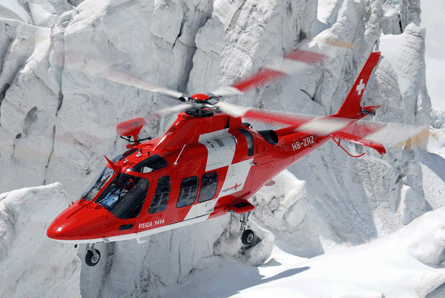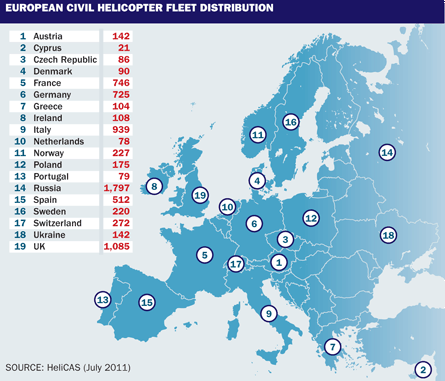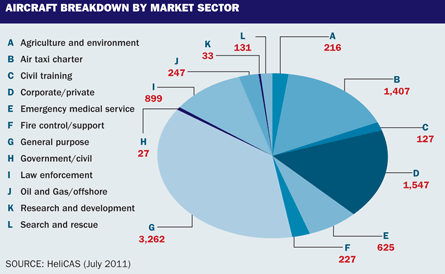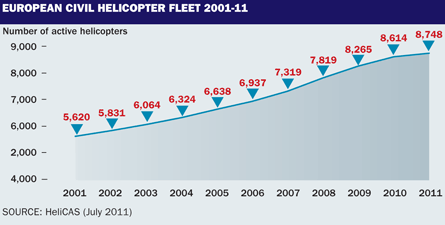The European civil helicopter market has experienced rapid growth over the past decade, as the acceptance of these versatile machines has gathered pace in a plethora of institutions and industries, from air ambulance providers to VIP operators.
According to Flightglobal's HeliCas database, the installed base of helicopters on the continent has climbed from 5,620 in 2001 to nearly 8,750 last month - representing the largest market outside North America. The rapid growth of the European civil helicopter sector is a reflection of the industry's phenomenal transformation worldwide.
"For decades, the civil helicopter market was the second smallest aviation segment, just above the equally stagnant trainer aircraft market," says Teal Group aerospace analyst Richard Aboulafia. "Turbine-powered civil helicopter deliveries averaged just $2 billion annually [in 2011 dollars] between 1988 and 2005, with very few signs of any growth." In 2006, however, deliveries rose to 573 helicopters, worth a record $3.3 billion. Delivery records continued to be smashed in 2007 and 2008, when the tally hit a high of 859 shipments worth $5.4 billion.
ECONOMIC IMPACT
The world economic downturn inevitably had an impact on this market, Aboulafia concedes.
Deliveries fell 13.8% by value in 2008-2010, and 2011 looks set to fall another 5%. However, demand has stabilised, and growth looks set to resume next year.
Market leader Eurocopter mirrors Aboulaifia's observations: "The downturn hit the industry hard," says vice president of marketing Dominique Maudet, executive vice president global business and services for Europe's largest provider, Eurocopter. "The level of bookings dropped off significantly in 2008, and by 2010 they were 70% lower than the previous year."
 |
|---|
© AgustaWestland |
Maudet says the sales of its single-engine products - notably the EC120 Colibi - were hit hard, as traditional buyers such as owner flyers and corporations could no longer afford or justify their continued use.
"The VIP/owner flyer sector is the part of the market most impacted by the downturn particularly in Western Europe. Helicopters tend to be one of the first things to go when an economic crisis hits," Maudet says.
This view is echoed by Robert Garavaglia, senior vice president of marketing for Europe's second-largest helicopter provider, AgustaWestland. "The corporate VIP market has declined because it is tied to the overall health of the stock market," he says.
The turmoil of the past three years has picked off the weakest players and shrunk the market, but "what remains is solid," he added. "Wealthy people will always be around. As with the business jet sector, the top end of the helicopter [market] - the VIP market - has not been as impacted as the lighter end, and the VVIP AW139 medium twin remains a popular choice."
Aboulafia agrees: "While helicopters have a much narrower customer base [than business jets], due to their shorter range and slower speed, that customer base is better able than ever to afford new models."
It is Europe's emerging markets - particularly Russia and the Commonwealth of Independent States - who are leading the sales surge for VIP helicopters, says Garavaglia.
This is thanks to a groundswell of wealthy individuals, a booming economy and a demand for Western helicopter models. Capitalising on this growth market, AgustaWestland has already established a second production line for the AW139 in Russia, and recently sold 20 of the types to Russian operator UTAir.
The country has fewer than 2,000 helicopters, and only half of these are in flyable condition, Aboulafia says. "The mature markets in Western Europe have been far more exposed to the financial markets than the CIS, but demand will recover in time," he adds.
OFFSHORE RESILIENCE
While the tally of corporate and VIP customers has dwindled, this decline has been offset by a sustained demand for helicopters from other market sectors.
The surge in offshore oil and gas exploration in particular has triggered a hugely lucrative helicopter support business, which the airframers are keen to exploit.
"Exploration and extraction is getting more expensive, as operators look to more distant oil fields and mine sites to meet growing raw material needs," says Teals Aboulafia. "Rotorcraft play a key and irreplaceable role in exploiting these remote sources."
Demand for helicopters to deliver public sector services - law enforcement, emergency services, firefighting and border patrol - has also remained strong across Europe. "Helicopters are the single most survivable and robust part of the transportation infrastructure," Aboulafia says. "They are essential for disaster relief, medical evacuation and community recovery."
 |
|---|
Garavaglia believes the use of helicopters for public sector services has become the norm across Europe. "Helicopters have become a social contract between a government and its citizens. They have become part of the mainstream and an integral, indispensable part of the community," he says.
As the European Union grows, other countries will expect the same standard of service for its citizens, opening up more opportunities, Garavaglia added.
Vittorio Morassi, chairman of the new European Helicopter Association, says the widespread use of public service helicopters has boosted the profile of the industry in Europe.
Before helicopters became mainstream, he argues, they were regarded as a rich man's toy, and the preserve of the privileged few. "They have been increasingly deployed in recent years to support local communities in a law enforcement, EMS [emergency medical services], search and rescue and firefighting roles, and their profile has risen tremendously," he says.
Despite their widespread acceptance, Morrassi believes the public service helicopter budgets of many European countries will be cut, as austerity measures being introduced by governments begin to bite.
"With the sovereign debt crisis affecting an increasing number of European nations - Spain, Portugal, Greece, Ireland and Italy for example - there will be more austerity in public spending. Helicopter budgets will inevitably be cut and services reduced and/or centralised," says Morassi.
Garavalglia agrees, but believes these measures will be short-lived. "There might be some short-term readjustment", he says, but helicopters have shown their effectiveness and value and have become indispensable.
LENDING FREEZE
While the demand in certain sectors remains strong, the financial crisis across has placed a stranglehold on bank lending across Europe.
This unwillingness to loan is affecting helicopter sales, as many operators cannot finance fleet expansion or renewal.
"Finance is tight for the banks, as they are heavily exposed to sovereign debt," says Robert Dranitzke, managing director of helicopter finance company Milestone Aviation.
The Dublin-based company was set up a year ago to exploit a niche in the helicopter finance market, and to date has secured more than $200 million in operating lease finance.
 |
|---|
"Many banks have a lending allocation for each market sector, and they have reached their limit with the helicopter finance. They are not even prepared to lend money to a good operator with good contracts," he says.
Milestone offers two finance options: it will buy the helicopter and lease it to the operator, or it will purchase the asset from the operator - who no longer wants the machine on their books - and then lease it back.
"We have done two dozen deals to date - four of these with European operators," Dranitzke says. "Helicopters are a good investment as they hold their value, particularly models at the top end of the range."
Milestone is choosy, however, about the type and operational role of the helicopter it is prepared to finance. "The VIP/corporate market is not for us, the asset is volatile to stock market fluctuations. When it drops the helicopter is often the first thing to go," he says.
Instead, Milestone's focus is on the offshore and public service providers, which Dranitzke says come hand-in-hand with stable, long-term contracts. "The heavy end of the market is strong - notably the EC225 and Sikorsky S92, which are popular offshore machines, along with the AW139 medium twin," he says.
Although Europe only accounts for a sixth of Milestone's business to date, Dranitzke is confident the region will flourish over the next few years. "We are a new concept in Europe, where operators have a tradition of owning their aircraft. However, we have had a positive reception from this market, and are very bullish about our prospects here," he says.
AIRCRAFT DEVELOPMENT
Despite the economic uncertainty, Europe remains a hugely attractive market for helicopter airframers, who are all seeking to carve a larger slice of the civil rotorcraft cake.
Eurocopter and AgustaWestland have already secured more than 60% of the market between them, and look set to retain their dominant position over the next decade, Teal's Aboulafia predicts.
There is no secret to their success, he suggests: "Both primes are willing to spend more on developing [and acquiring] new products and creating a comprehensive product range."
 |
|---|
Over the past 14 years, Eurocopter has consistently updated its product line with the EC series, starting with the EC120 and including the EC130, 135, 145, and 155.
The next step will be the EC 175, a joint venture with Aviation Industries of China II/Harbin Aircraft, which will compete with the AW139 when it enters service next year.
AgustaWestland "has long relied on its A109 family for the bulk of its civil market presence", Aboulafia says. The product line has been expanded to a wide variety of variants, incorporating greater range and engine power.
The single-engine version - the AW119 Koala - is now available with more power, as the 119 Ke (Koala enhanced). The baseline 109 is now available as the larger 109 Grand, updated as the Grand New in 2010, with a new avionics package.
Aboulafia adds: "The company will capitalise on the success of its AW139 with the proposed AW169 - a light twin positioned between the Grand and the 139, and set to compete with the EC 235 Dauphin when it enters service in around 4 years.
"The best illustration of AgustaWestland's determination to grow its product line is its June 2011 acquisition of the entire Bell/Agusta 609 tiltrotor programme. It will be brought to market by 2015, although its market standing remains highly uncertain."
Sikorsky also has a strong presence in the medium and heavy sectors, with its S-76 and S-92 respectively, and hopes to secure its position with the introduction next year of its S-76D.
Bell has seen its share of the European market fall from around 30% to 14% of new aircraft sales over the past thirteen years, and is now fighting back.
The Textron-owned company appointed senior Eurocopter executive Patrick Moulay to head up its commercial operation in Europe last month, hoping to drive sales of its renewed and revived product line.
"Bell hasn't done that well in Europe because it hasn't had the right products," Moulay admits. "The 427 light twin was not certificated for instrument flight rules [IFR] operations, so sales were limited to VIP [owner flyer segment]," He explains.
The more lucrative sectors, such as law enforcements and EMS, were out of Bell's reach, he added.
Moulay is confident its IFR approved 429 - an all new replacement to the 427 - will reverse Bell's fortunes in the region, despite Eurocopter's dominance of this segment with its EC135.
"We are writing a new chapter," he says. "The 429 is the right aircraft at the right time. We have already delivered seven of the types in Europe, and sold two aircraft in late August.
"Many EMS operators have fleets that are up to 20 years old, and they are looking at the 429 as a replacement aircraft. This is going to be the next big thing."
Bell is also planning to take on the AW139, EC235 and S76 medium twins, with a new enhanced 412, the 412EPI.
Although he remains tight-lipped on the aircraft specifications and planned entry into service, Moulay says the aircraft will have new engines, a glass cockpit and full authority digital engine control, and will be targeted at the onshore utility market.
Not to be outdone in the single helicopter segment, Bell has also launched its 47GX. The aircraft is an upgraded version of the Model 407 - of which Bell has sold around 1,000 - and will enter service in Europe early next year.
"Europe is going to grow for Bell," Moulay says. "We are investing heavily in our Prague facility to bring full in-house capability to our customers.
"With our with our new product line we hope to secure 20% of new sales to the civil and para public market within three years. There is a will and commitment from the company to come back to Europe."
Source: Flight International
















